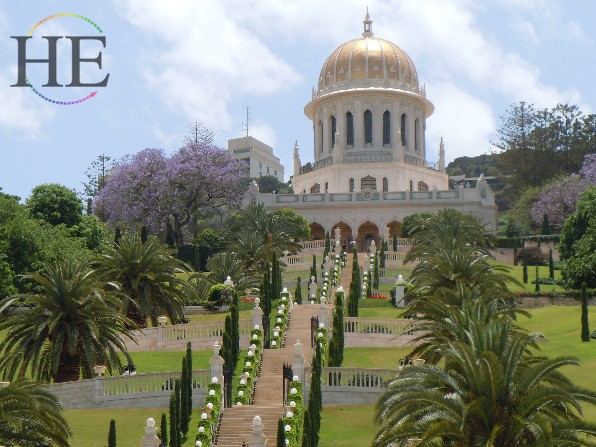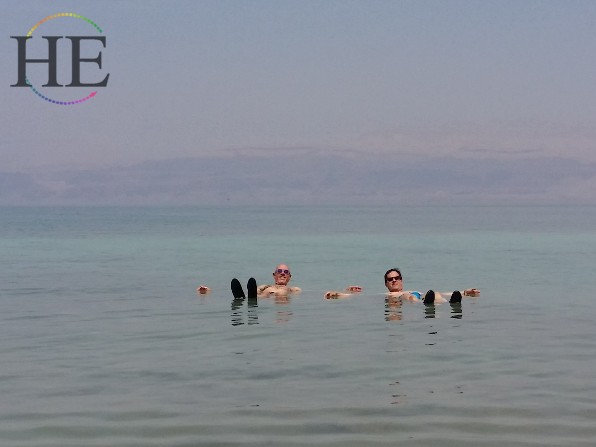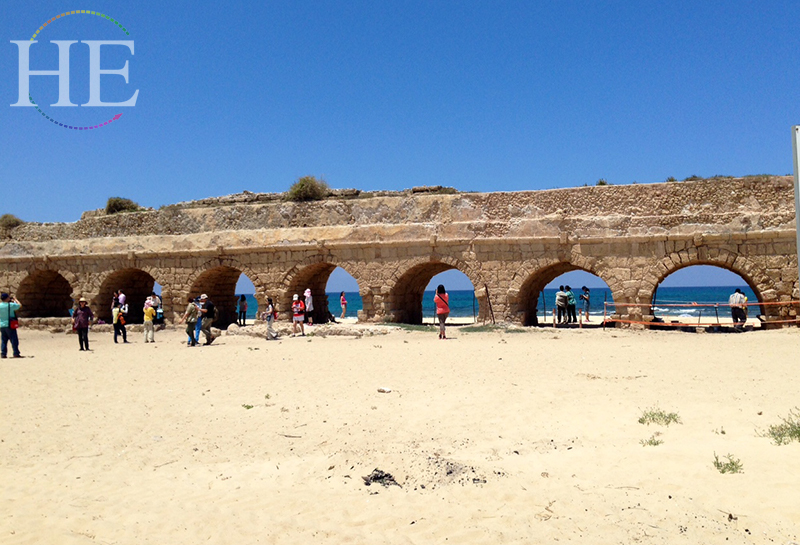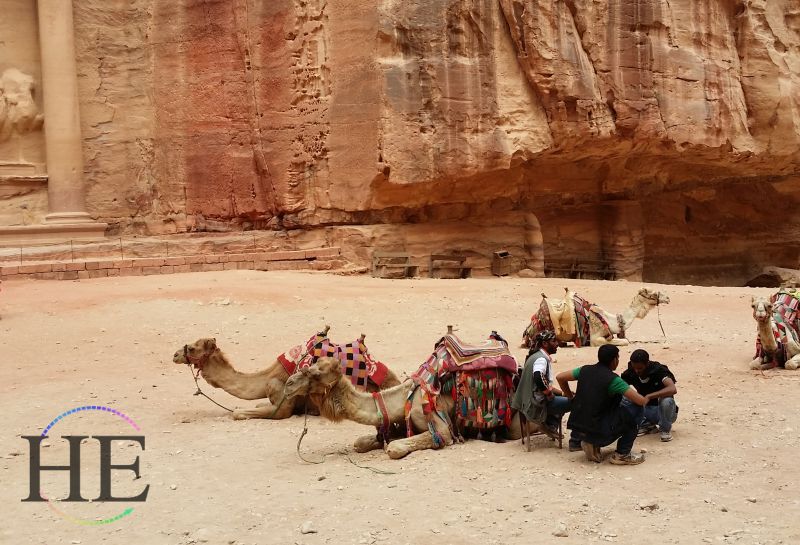Gay Travel Israel Pride and Heritage Cultural Tour
A Gay Travel Israel Cultural Tour
Prices listed are per person:
Shared Room: $8598
Private Room: $11,098
Explore the complexities, beauty, and challenges of ancient and modern life on this gay Israel cultural tour. We will uncover the archaeological beginnings of three great religions, introduce you to a thriving LGBT community, and expose you to the social labyrinths of modern Israel. Consider our optional extension afterward to visit Petra and other landmarks of Jordan.
Highlights
Start and end the tour in a beachfront hotel in modern Tel Aviv, near the gay beach.
Celebrate Pride in Tel Aviv (when Pride dates align with our tour).
Enjoy in-depth tours of archaeological sites.
Spend two nights in a gay-friendly kibbutz.
Hike along the lush Sea of Galilee and take a jeep ride to the Golan Heights.
Tour the Old City of Jerusalem including the most famous religious sites.
Explore the ancient citadel of Masada, then float in the Dead Sea and enjoy the sights and sounds Israel has to offer.
Meet a variety of Israelis to learn more about gay life in Israel and to see how the people live and love their land, with discussions about contemporary life in Israel.
Extend your stay to visit Jordan, including Petra, Wadi Rum (Lawrence of Arabia’s desert abode), Amman, and the Jordan Valley. See the Extensions tab for details.
Overview
A Walk Through History
Home to three of the world’s most important religions, and filled with significant historical and cultural sites, Israel is unlike anywhere else in the world. Modern Israel is a rich mosaic of ethnic and religious groups, each with longstanding ties to the land. To offer a more in-depth understanding of these communities, our gay Israel tour not only explores the landscape and history of Israel but features interactions with representatives of some of Israel’s diverse groups. We start our tour in modern Tel Aviv. We will then drive around central and northern Israel to visit Haifa, the Sea of Galilee, and the Golan Heights. We will also explore the most famous sites in and around Jerusalem including King David’s tomb, the room of the Last Supper, the Western Wall and the Arab market. Another day will feature the ancient fortress of Masada overlooking the Dead Sea and a swim in the salty sea, far below sea level. Join us on a journey to this unique land as we explore ancient sites and contemporary life and enjoy the hospitality of this gay-friendly nation during our guided gay travel through Israel.
And for those with more time, our three-night extension to Amman and Petra in Jordan adds another rich chapter to your exploration of the region.
Itinerary
Map:
Day 1: Arrival in Tel Aviv

Upon arrival at Ben Gurion Airport, halfway between Tel Aviv and Jerusalem, our airport VIP staff will escort you through expedited airport formalities. They will then transfer you to our beachside hotel in Tel Aviv.
This evening enjoy a welcome dinner where you can meet your fellow tour members. We will also provide all participants with a list of optional places to visit tonight for anyone with the energy to go out on the town.
Days 2: Old Jaffa and New Tel Aviv
On our first full day in Israel, we will explore the vibrant coastal city of Tel Aviv together, including the old port of Jaffa and the Bauhaus-inspired new district of Tel Aviv. One memorable sight is Independence Hall on Rothchild Blvd, where David Ben Gurion declared Israel’s independence in 1948.
Along the way, we will visit Neve Tsedek, the first Jewish neighborhood in the northern area of Jaffa, which today is a cultural and entertainment center. Another stop will be Old Jaffa, now home to many art galleries, but the most important port in ancient times. Through this port, the cedars from Lebanon were imported for use in building Solomon’s Temple in Jerusalem.
Day 3: Tel Aviv Pride Party

Enjoy a leisurely morning as later today as today is a day to take in the atmosphere as you wish. Head down to the seashore and enjoy the warm spirit of the local gay community. Head to Nachalat Binyamin, an open-air market in the heart of Tel-Aviv.
When our tour dates overlap with the Tel Aviv Pride celebrations, which they do for 2024, our guide will recommend how best to join in the festivities. Pride usually kicks off with a festival of music and drag shows, followed by one of the largest Pride parades in the world. The day concludes with a party at the Charles Chlore Beach.
Day 4: Haifa

We start our day with a leisurely morning. Then we will drive north along the coast of the Mediterranean Sea to the well-preserved port city of Caesarea. King Herod dedicated this city to Caesar Augustus more than 2,000 years ago. Among other sites that are still standing are a Roman amphitheater and an aqueduct.
Continuing north, we will visit the busy market of the Druze village of Daliat El Carmel. Next, we will take a panoramic drive through Haifa. A highlight will be the newly renovated Baha’i Temple with its golden dome and Persian gardens.
Day 5: Akko
We will continue north to the ancient town of Akko, just a few miles south of the Lebanese border. Inside this walled city are fortresses, citadels, churches, and mosques. These all depict the history of the many rulers, like Canaanites, Greeks, Romans, Crusaders, and Mamelukes. We will then make our way to the old city of Acre, designated by UNESCO as a World Heritage site.
This evening we will enjoy the surprisingly lush green hillsides of the region called Galilee, as we drive through Tiberias, and alongside the Sea of Galilee (actually a large lake). Our home for the next two nights will be in the comfortable, modern guesthouse of a Kibbutz in the thin finger of Israel between Lebanon and Syria.
Day 6: The Galilee and the Golan Heights

During our one full day in the north, we’ll take a jeep ride to the Golan Heights, and visit the Banias, also known by its Roman name of Caesarea Philippi, the major source of water for the Jordan River. We’ll continue across the Golan Heights to visit the ancient synagogue at Katzrin and discuss the strategic value of this controversial region while viewing the Sea of Galilee to the west and Syria to the east.
Enjoy a stop for wine tasting at one of the emerging boutique wineries in the region, before returning to our kibbutz for one more night.
Day 7: On to Jerusalem!

Today we drive south through the Jordan Valley, from Israel’s northeastern tip toward Jerusalem. Along the way, we will drive by Gilboa, where King Saul and his son Jonathan were killed and where David wrote his famous poetic legacy to his lover. We will also pass Capernaum and the modern Palestinian West Bank city of Jericho.
One of today’s highlights will be a visit to Beit Shean, one of the most magnificent archaeological sites in Israel. It is located at the strategic juncture of the Jezreel and Jordan Valleys. Like Jericho, it has been almost continuously inhabited throughout history. It was the capital of the 10 Greek cities called the Decapolis.
We’ll start our exploration of Jerusalem with a panoramic overview from the Mount of Olives, which lies across an ancient valley from the Old City. Once we arrive at our deluxe hotel just outside the city walls, the rest of the evening will be free to start your exploration of this unique city.
Day 8: Old City of Jerusalem

Our appreciation of the historic Old City of Jerusalem will include visiting elements of all four quarters: the Jewish, Arab, Christian, and Armenian sections. Our Jerusalem touring will include Mount Zion, with King David’s Tomb and the Room of the Last Supper.
We will visit the Western Wall, the Southern Excavations, the Broad Wall, and the Cardo, a 2000-year-old shopping street. After lunch on your own, we head on to the Christian Quarter for a walk on a portion of the Via Dolorosa. We will also see the Church of the Holy Sepulcher, which is jointly maintained by six Christian denominations.
No visit to the old city of Jerusalem would be complete without a visit to the Arab market to test your negotiating skills with the local merchants. As you make your way towards the Jaffa Gate, walk by the Citadel of David. Don’t forget to pay your respects at the two almost forgotten tombs on your right – those of the architects of the Old City Walls. They were killed by the Ottoman sultan Suleiman the Magnificent in 1538 since they were the only people who knew all of the “secrets of the wall.”
Day 9: Yad Vashem

Today we will head outside Jerusalem’s city walls to visit Yad Vashem, Israel’s memorial to the Holocaust Victims.
On a lighter note, we will enjoy a walking lunch at the Machane Yehuda marketplace. A local expert will help us see the mosaic of contemporary Jerusalem. The food in the market represents the people who have emigrated to Israel from every corner of the world. The graffiti on the walls shows what they are thinking about.
During our tour, we will learn more about the latest walls to surround Jerusalem, Israel’s controversial Security Barrier. We will gain insights as to why some Israeli’s credit this wall for a significant reduction in violence against Israeli Jews, and why the Wall is viewed by others as a deep insult against Israel’s Palestinian community.
Day 10: Masada and the Dead Sea

We depart Jerusalem with one last look at the Old City from Mount Scopus, home of Hebrew University.
Then we head east to begin our exploration of the Judean Desert and the biblical mountains of Moab along the Dead Sea. We will stop at Masada, where we will ascend to the top via a cable car. This mountaintop fortress is best known for the long siege of a small band of martyrs who were trapped there by Roman soldiers. However, it was originally built by King Herod, and still retains colorful elements of his royal rooms.
After touring Masada, we slow down our busy touring schedule with lunch at a hotel overlooking the Dead Sea. We will pause for an enjoyable “swim/float” in the world-famous rejuvenating waters of the Dead Sea. The water is so salty that it is easier to float than to try to swim! The Dead Sea is over 1000 feet below sea level, so its distance from the sun and the ambiance of the air make it almost impossible to get a sunburn.
Time permitting, we will take a short hike in the Ein Gedi Nature Reserve in the hills overlooking the Dead Sea. We will then return to our Jerusalem hotel.
Day 11: Tour Day in Jerusalem
Today we will tour Jerusalem with our guide and tonight we will enjoy our Farewell Dinner.
Day 12: Departure Day or Start Jordan Extension

Today is a day at leisure to relax and recuperate before your flight home or the start of some extra days in Israel. (The transfer to Ben Gurion International Airport is included in the tour fee if you depart on the last tour day or arrange an extended stay with us).
Or you can join us for a rewarding extension to the Hashemite Kingdom of Jordan, including Amman and the memorable archaeological site at Petra. In 2007 Petra was selected in a worldwide Internet vote as one of the New Seven Wonders of the World. Join us to see why! See the Extensions tab for details.
Price Includes
Israel Pride and Heritage Tour
Price includes: Accommodations for 11 nights; All group ground transportation during the trip; Airport transfers between Ben Gurion Airport and our Tel Aviv hotel; Breakfast every day, two lunches, and five dinners; Wine or soft drinks at the Welcome Dinner; Services of a professional Israeli guide; Services of a knowledgeable HE Travel tour host (with a minimum number of participants); Entrance fees to all sites in the program; All hotel service charges, government taxes, porterage, and gratuities for drivers and included meals. HE Travel provides complimentary Medical & Evacuation Insurance for every US Resident on our group tours who does not have other coverage.
Not included: Airfare between home and Tel Aviv; International departure taxes; Meals that are not part of tour itinerary; Gratuities for guides, driver, hotel staff and HE Travel host; Personal items such as alcoholic beverages, telephone calls, laundry, and COVID-19 testing (if required).
Jordan Extension
$2998 per person in a shared room
$3598 for one solo traveler in a private room and bathroom
Price Includes: 1 night in Wadi Rum, 1 night near Petra and 1 night in Amman; 3 breakfasts, 3 lunches, 3 dinners; all ground transportation and admissions fees; services of an English-speaking guide; Jordan visa, taxes, and fees for VIP services at the border; flight from Eilat to Tel Aviv; medical and evacuation insurance.
Not Included: Additional night in Tel Aviv and airport transfer (if needed based on flight times); Gratuities for guides and HE Travel host; Personal items such as alcoholic beverages, telephone calls, and laundry.
Extensions
Jordan, Petra, & Moses – June 16 to 19, 2024
Day 12: The Desert Lands of Lawrence of Arabia
For travelers who continue to Jordan, we will transfer this morning to Ben Gurion airport’s domestic terminal for a short flight to Eilat. Upon arrival, we will make a short drive to the border. After Israeli and Jordanian formalities, we will meet our Jordanian guide on the Aqaba, Jordan side, then begin exploring.
On our drive we will stop at Jordan’s Red Sea port town of Aqaba for lunch at their finest seaside hotel. We will then continue our drive north to Wadi Rum, the desert headquarters of Lawrence of Arabia. Next, we will embark on a 2-hour 4×4 ride into the desert. High dunes and sandstone and granite cliffs surround this large valley. Lawrence of Arabia used this base for his operations during the 1917-1918 Arab Revolt.
We will finish the day with a camel trek through the desert and check in to our glamping spot with some leisure time before dinner.
Day 13: Petra: One of the Modern Seven Wonders
The next morning, following an early breakfast, an extraordinary day awaits us as we approach the ancient Nabatean capital of Petra. From the site’s main entrance, we’ll walk into the chasm (called a siq in Arabic) that ripped through the rock in a prehistoric quake.
Petra’s most famous monument, the Treasury, appears dramatically at the end of the siq. We will explore the Treasury, the Monastery, the 3000-seat first-century theater, and other sites. Marvel at the rose-red stone and how the colors change as the day progresses.
After lunch, you can explore more of Petra on your own or relax and enjoy the amenities of our unique lodging just outside the entrance to Petra.
Day 14 Madaba – Mount Nebo – Amman
From Petra, we head north on the 5000-year-old King’s Highway to Madaba, the city of mosaics. We will visit the Greek Orthodox Church of St. George, known for its sixth-century Byzantine mosaic map of the Middle East.
After lunch, we will enjoy the view from Mount Nebo from which Moses is said to have viewed the Promised Land.
We will finish our day’s touring with a short overview tour of Amman, a city that was already a thriving metropolis during Roman times. City highlights include the Citadel, the Roman Theater, and the King Abdullah Mosque.
Our dinner will be with a very special local community leader at an Amman restaurant.
Day 15: Departure
This morning we will enjoy a tour of Jerash, the spectacular Graeco-Roman city. We will visit Amman, including the Roman amphitheater, marketplace.
We recommend scheduling flights from Amman in the early evening, but we can also provide a transfer to Tel Aviv’s Ben Gurion Airport upon request(for an additional fee).
For anyone who added hotel nights back in Tel Aviv, we will transfer you to your Tel Aviv hotel, then to Ben Gurion Airport for your flights home. Please let us know if you would like us to reserve extra hotel nights for you.
Tour Insurance
We strongly recommend the purchase of Trip Cancellation and Interruption insurance to protect your vacation investment in case of unforeseen circumstances such as flight delay, illness, or injury. Click Here to learn more about our Insurance partner.
FAQ
The Cenaculum is in the upper story of David’s Tomb on Mount Zion. This is the site of Jesus’ Last Supper – a Passover Seder. It was on this occasion that Jesus gave his disciples bread, saying “This is my body” and wine saying “This is my blood”. Tradition also associates this site with the miracle of Pentecost.
The Cardo is one of the most conspicuous Roman-Byzantine sites. It was built atop the ruins of Jerusalem in 70 and 135 AD. It has 2 broad thoroughfares intersecting at right angles. One section of the Cardo (the closed Cardo) has been completely restored and has many small stores where segments of other archeological discoveries can be seen amongst the stores.
The Convent of the Sisters of Zion was built on a site that has yielded remains of ancient ruins from the Roman era. Inside the church a flight of stairs leads down to the Lithostratos (stone floor). The heart of the church is an ancient arch built of small stones.
Damascus Gate is one of the original 7 gates of the walled city of Jerusalem built during the 16th century by the Ottoman Ruler Suleiman. Originally it had 7 gates. An 8th was added in the late 19th century, very aptly named The New Gate. Damascus Gate is one of the largest gates located on the northern side.
Dome of the Rock (Al Aksa Mosque) is one of the oldest Muslim monuments in existence, but is often closed to the public. It was completed in 691 AD. The building has been modified and renovated throughout the history of mankind, even serving as a Crusader church where its 7th century format has still been preserved. This structure is distinctive for its precise geometrical proportions and golden dome.
Dominus Flevit Franciscans Church, whose Latin name means “The Lord Wept,” marks the place where Jesus wept for the city’s future destruction before his crucifixion. This prophecy came true in 70 AD when opulent Jerusalem was leveled by the Romans. Most churches in Jerusalem face east; this church however faces west.
The Golden Gate is a sealed gate on the eastern side and was built during 640 AD, either by the last of the Byzantine rulers or by the first of the Arab conquerors. Tradition equates this gate with the one mentioned in Ezekiel’s prophecy. It is also believed that an earlier gate is preserved underneath the current gate.




